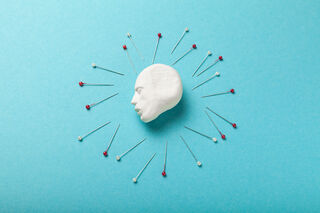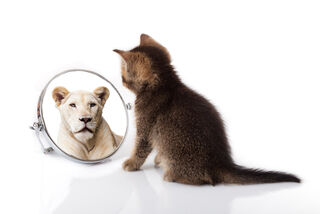Divorce
How to Challenge the Substance of Emotional Pain—and Defeat It
The MIRROR method can help you manage and modify psychological pain.
Posted March 7, 2022 Reviewed by Ekua Hagan
Key points
- Physical and emotional pain have similar neural signatures.
- Emotional pain, like physical pain, can compromise long-term health.
- (HRV) Heart rate variability and diaphragmatic breathing shows positive outcomes for modifying the experience of emotional pain.
- Using a process like MIRROR can help one understand painful experiences differently and open pathways for regulating emotions.
I remember reading the story of Bartleby the Scrivner by Herman Melville in college many years ago. Particularly, his infamous line “I prefer not to” and reflecting on how deeply we can all have times where we may seek to simply avoid things, to the point of a decremental obligation to live our lives in healthier ways. This, however, is not about the numerous ways we can be hurt and avoid psychological pain. Instead, it is about how we can find ways to rise above our circumstances and, as psychologist Robert Leahy said, “create a life worth suffering for” (Leahy, 2019).
Mental anguish, pain, and suffering are a part of life. Truly, it is the part we would probably rather avoid, and why not? Painful experiences bring with them an array of issues alongside the prospects for immense grief.

Our avoidance of confronting tough issues that lead to painful experiences has even given rise to a new generation of phrases—like “conscious uncoupling” in reference to divorce—as an attempt to emotionally blunt the process. Researcher Angelsti (2006) states that although divorce might come as an initial relief to some, it is also inevitably accompanied by feelings of helplessness, aggression, sadness, guilt, and loneliness. In my own personal experience with clients who have been through a divorce, when asked about their experience, they have stated that it felt very similar to a “death in the family.”
According to research on pain (Bao et al., 2020), “psychological pain, distinguished from physical pain, can be considered the introspective experience of negative feelings, like shame, guilt, dread, and despair.” Physical pain, however, can inversely usher in emotional overtones, and reciprocally, emotional pain can also become physically painful (Bakalar, 2004). The reason for this is that emotional and sensory pain both share the same nervous system with similar neural signatures, and the brain doesn't really interpret them as mutually exclusive, thus, pain is simply pain. But, how we carry pain can determine various outcomes; many impacting, some devastating, but others that are truly awe-inspiring (Bakalar, 2004).
Pain and the heart
It shouldn’t come as any surprise that painful emotions can and do affect the heart. If you get too angry, your blood pressure spikes. If you are scared, your heart begins to pound. If you suppress emotions, the prospect of heart disease becomes higher. In fact, studies looking at (HRV) heart rate variability (or the variation of time between each heartbeat) show the positive outcomes of good HRV and higher emotional well-being.

HRV is a response to what scientists call physical oscillatory signals coming from things like regulated breathing (diaphragmatic) and blood pressure changes where the heart rate slows (such as in meditation) or speeds up in response to certain rhythms and frequencies (Mather et al., 2018). This link between emotional regulation and our ability to influence bodily responses to stimuli shows a distinct correlation between exercising our inherent strength as humans for modulating responses to painful experiences and ultimately affecting better health (Mather et al., 2018).
Challenging the status quo
We can change how we feel. Exercising inner control can be a potent tool against painful experiences and memories (Kalb, 2004). Psychiatrist and pain specialist Michael Moskowitz has worked in the specialization of brain neuroplasticity for years and understands the importance of counterstimulation for helping the brain process pain in improved ways. Moskowitz (Doidge, 2016) uses the acronym MIRROR (Motivation, Intention, Relentlessness, Reliability, Opportunity, and Restoration) for his method of working with chronic pain patients and we can adapt it here to the management and modification of psychological pain as well. Let’s look at each step.

Motivation—The first step is moving from passivity to actively taking charge of the emotional pain felt so that when such reminders emerge, we can instead, change our perception of them. Therefore, where once we may have felt dread, the psychological shift becomes the view that emotional pain is now viewed as a “primary motivating” mechanism. This signaling tells one that it is time to act, to resource, and fight the unhealthy feelings associated.
Intention—As Moskowitz sees it (Doidge, 2016), Intention is about our true understanding of what is required to change the pain factor, which is not to unrealistically make the experience disappear, but to minimize its harsher effects at the moment.
Relentlessness—Simply put, when pain intrudes into our consciousness, we can recognize it as a “signal to start pushing back” (Doidge, 2016). Tolerating pain doesn’t work well. For emotional pain, it is sometimes “action before motivation” that is needed to change the experience. We must, as Moskowitz explains, be relentless, non-accepting, and push back. If diaphragmatic breathing isn’t working for the moment, then shift to a casual walk, writing, or something else that distracts your thoughts from the emotional center of the brain.
Reliability—It’s important to remind ourselves when engaged in a painful experience that our brain and our mind are not the enemies here and nor do we need to castigate ourselves. When the brain and body as a system remind us of a painful experience, it is actually looking for ways to inform us that something is amiss and that we should tend to it. We must know we can rely on our brain to help us because consequently, it is the brain that can turn conscious effort into behavioral action.
Opportunity—Every painful experience can be seen as an opportunity to rally oneself constructively. This is using the pain spike to identify the issue and therein repair the alarm system going off, therein is the opportunity.
Restoration—Finally, in this last step, we simply need to evaluate whether our actionable steps indeed achieved some measure of emotional restoration.
When it comes to painful experiences, Dr. Marylyn Schlitz states the following about our capacity to grow beyond the pain:
“painful experiences have the capacity to loosen our sense of control over our life circumstances. This can be a good thing. They can help to dissolve our fixed identities in ways that broaden our understanding of who we are and what we are capable of becoming” (Schlitz, 2015).
Using approaches like mindfulness and meditation, and their respective tools for things like pacing respiration when we are hurting, learning to be calm and detach from pain, or forced opposite responses like going for a walk over staying in bed, are ways you can bring MIRROR to the forefront for healing the pain in your own life. Noted psychologist Erich Fromm believed that to spare oneself from pain would require total detachment, and the price for that would also mean our ability to experience true happiness. (Kessler, 2020).
References
Angelisti, A. L. (2006). Hurtful interactions and the dissolution of intimacy. In M. A. Fine & J. H. Harvey (Eds.), Handbook of divorce and relationship dissolution (pp. 133–155). Mahwah, NJ: Erlbaum.
Bao, J., Li, H., Song, W., & Jiang, S. (2020). Being bullied, psychological pain and suicidal ideation among Chinese adolescents: A moderated mediation model. Children and Youth Services Review, 109. https://doi.org/10.1016/j.childyouth.2020.104744
Bakalar, J. (2004, September 27). Depression Hurts. Newsweek, 64.
Doidge, N. (2016). The Brain’s Way of Healing: Remarkable Discoveries and Recoveries from the Frontiers of Neuroplasticity (Updated ed.). Penguin Life.
Kalb, C. (2004, September 27). Budha Lessons. Newsweek, 51.
Kessler, D. (2020). Finding Meaning: The Sixth Stage of Grief. Scribner.
Leahy, R. L. (2019). Emotional schema therapy. Guilford.
Mather, M., & Thayer, J. F. (2018). How heart rate variability affects emotion regulation brain networks. Current Opinion in Behavioral Sciences, 19, 98–104. https://doi.org/10.1016/j.cobeha.2017.12.017
Schlitz M. (2015). Death Makes Life Possible: Revolutionary Insights on Living, Dying, and the Continuation of Consciousness.




